Do you wish you had a roadmap that showed you exactly what you need to do to achieve your nonprofit’s biggest goals through marketing? An effective nonprofit marketing plan can do just that. While many nonprofit marketing plans simply sit on a shelf gathering dust, there IS a way to build a better plan you’ll actually use – one that aligns your marketing efforts with your organization’s strategic plan, helps you prioritize and make time for what matters, and identifies the best strategies and tactics for moving your mission forward.
We create dozens of plans that check all of those boxes every year for our nonprofit clients. Now, we’re pulling back the curtain and showing you how we do it with our Essential Nonprofit Marketing Plan Template. The template is one part example, so you can see what a successful nonprofit marketing plan looks like, and part workbook, so you can begin building your best marketing plan and advancing your mission through marketing.
Here’s a look at what’s inside, and the elements you’ll need to consider when building a nonprofit marketing plan for your organization:
Mission and Vision
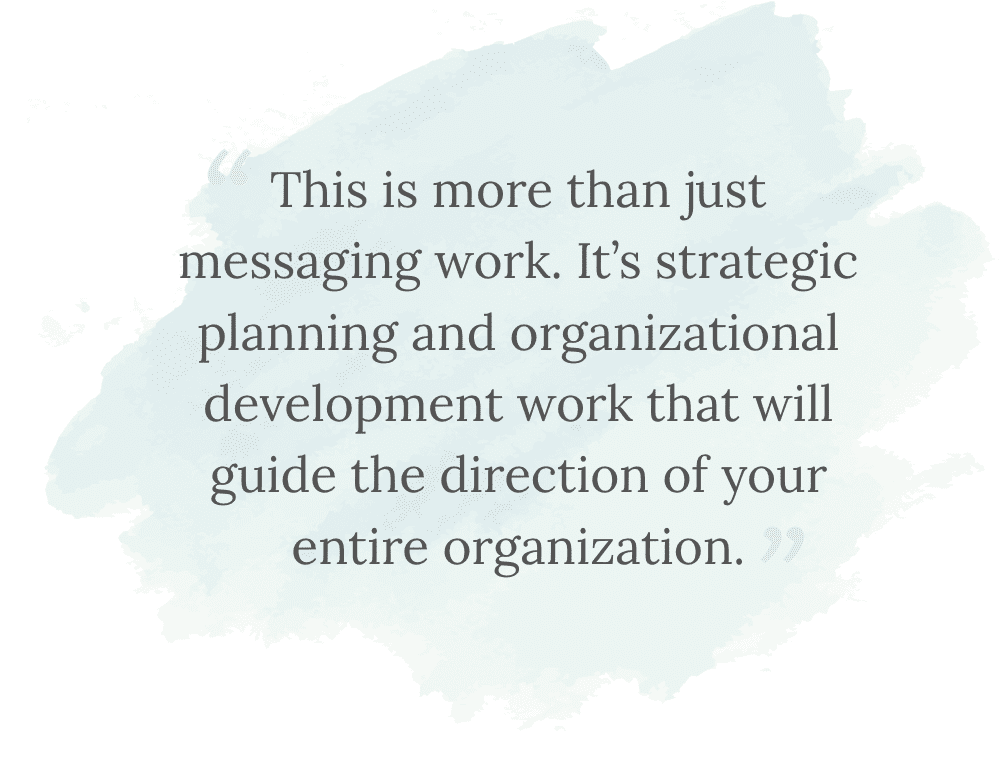
Every part of your marketing plan must stem from your mission and vision. A mission and vision are so much more than just statements. They’re the grounding principles that define the future your nonprofit is working to create and the work you’re doing every day to get closer to that reality. They determine the strategic priorities your organization sets, and those strategic priorities guide where you should direct your marketing and communications efforts. It’s all inextricably tied. We suggest you open your nonprofit marketing plan by stating your organization’s mission statement and vision statement. This will ground everyone who interacts with your plan in what matters most.
The Essential Nonprofit Marketing Plan Template assumes you already have an effective mission and vision in place, but many organizations don’t. Many of our clients come to us with mission and vision statements that are outdated, ineffective, or misaligned with their current strategic direction. When that happens, we facilitate mission and vision workshops that help our clients discover truly powerful mission and vision statements they’ll use for many years to come. This is more than just messaging work. It’s strategic planning and organizational development work that will guide the direction of your entire organization.
Learn more about how to develop your nonprofit’s mission and vision statements here.
Nonprofit Marketing Audit: Assess Your Organization, Ecosystem and Stakeholders
Every marketing planning process should begin with thoughtful engagement of your nonprofit’s stakeholders via a stakeholder assessment. This means asking folks like your program participants and beneficiaries, donors, community members, board members and staff how they currently perceive your nonprofit’s approach to communication and marketing, and where they think you can improve. This can be done at the onset of the planning process through surveys and interviews, but don’t stop there. Continuing to engage these diverse stakeholders through the entire marketing planning process is critical, which should come as no surprise to those familiar with our Shared Power Strategy™ philosophy.
Before you begin to determine where you’re going from a marketing perspective, it’s also essential to evaluate where you’ve been by conducting an organization assessment. Whether your nonprofit’s marketing function is robust and sophisticated or small and nascent, you surely have access to at least some marketing data and insights that
will inform your plans moving forward. In our Essential Nonprofit Marketing Plan Template, we’ve made space for you to fill in information about your web traffic, social media engagement, email engagement, and overall marketing activities. These are some of the things most nonprofits are able to audit, even if they’ve never had a formal marketing plan. We suggest auditing these areas with a consistent set of dates in mind (typically the most recent full calendar year). When working with the template, feel free to skip (and delete) any pages you’re unable to fill in, and add additional pages for other areas you’d like to assess, such as PR, events and community outreach.
Lastly, as you prepare to dive into marketing and communications planning for your nonprofit, conduct an ecosystem assessment by evaluating the marketing and communications of other, similar nonprofits, or those that compete for donor dollars and community support. Take a look at how their brands, positioning and messaging compare to your own, and think about whether there are opportunities to further differentiate your nonprofit.

To help you sum up your findings from your assessment of your stakeholders, organization and ecosystem, we’ve included a page in the Essential Nonprofit Marketing Plan Template for a SWOT Analysis, where we encourage you to take a high-level look at your nonprofit’s marketing strengths, weaknesses, opportunities and threats so you can determine the areas that most need your focus in your marketing plan.
Nonprofit Marketing Pillars, Objectives and Key Results
Through our work with hundreds of nonprofits, we’ve noticed a common mistake when it comes to setting marketing goals; most organizations set their marketing goals in a vacuum. They do not begin with their strategic plan and mission in mind and then set aligned marketing goals that will drive both forward. As a result, they end up with goals that sound good on paper, but do not make a strategic and thoughtful use of the organization’s time, budget and brainpower.
That’s why we prefer to use a set of tools called pillars, objectives and key results in place of traditional goal setting. Pillars, objectives and key results virtually ensure your organization will be focused on the right things at the right times in order to position marketing to move your mission forward.
The pillars section of the Essential Nonprofit Marketing Plan Template will help you come up with a long list of potential pillars – or areas of focus for your marketing plan – that align with your strategic plan. Then, it will help you prioritize between those potential based on the size of your team and marketing budget, and narrow down to just a handful.
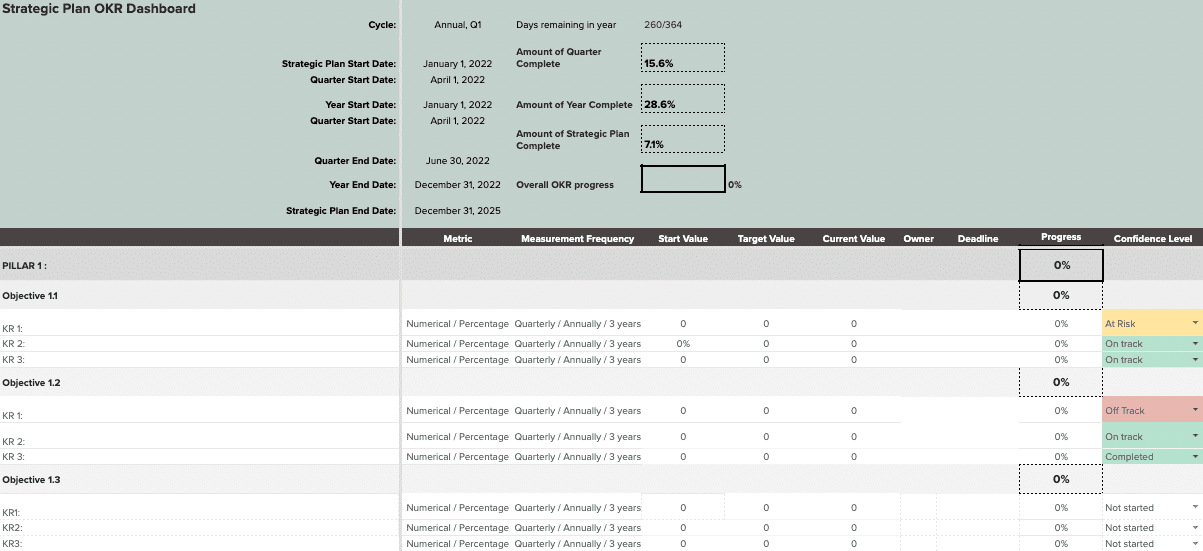
A marketing dashboard for a nonprofit marketing plan
Next, you’ll set ambitious, yet realistic objectives and measurable key results under each pillar that are tied directly back to your strategic plan, and put those items on a marketing dashboard that will hold everyone on your team accountable. The Essential Nonprofit Marketing Plan Template will walk you through the entire process of setting marketing pillars, objectives and key results. It will also show you how to account for “keep the lights on” activities that don’t fit within any pillar, but are a necessary part of marketing your organization (for example, sending an email newsletter or posting and engaging on certain social media communities).
Following a pillar, objective and key result setting process like this one will help you develop more realistic and achievable nonprofit marketing goals and prioritize them so you don’t overwhelm your team or set yourself up for failure. However, even with the right tools, it can sometimes be difficult to set your own, unbiased pillars, objectives and key results, especially when you’re intimately involved in the work that will result from them.
That’s why at Prosper Strategies, we go deeper than simply working through the worksheets in our Essential Nonprofit Marketing Plan Template with our clients. We scrutinize every pillar, objective and key result they propose and help them determine if it’s actually the right one, and the most important one, for their organization’s overall strategic goals, mission and vision. We also challenge false beliefs about what can be accomplished within the current constraints of our clients’ teams and budgets. Sometimes, this results in scaling back and getting more focused. Other times, it results in thinking bigger and pushing the boundaries.
Tactical Selection
Once you’ve selected your pillars, objectives and key results, it’s time to match them up with the marketing tactics that are well suited to carrying them out. Most of our clients want to jump right into this part of the marketing planning process. However, it is absolutely essential to do the work detailed in the earlier parts of the Essential Nonprofit Marketing Plan Template before you can successfully tackle tactical selection. Now that you know what you’re focused on (your pillars), what you’re trying to achieve (your objectives and key results), and what else you need to do to maintain marketing and communications (your “keep the lights on activities”) you can choose the vehicles to make it happen (your tactics).
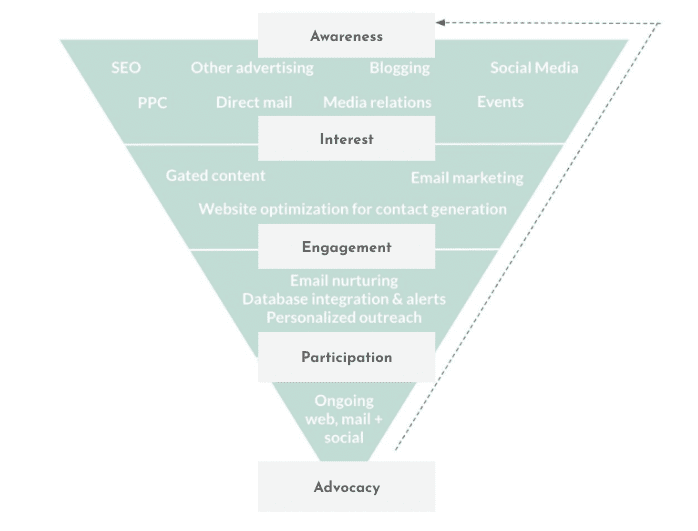
Inside the template, you’ll find our tactical selection funnel. This funnel illustrates the four phases most nonprofit stakeholders move through when deciding to take a desired action like volunteering, donating, or signing up for one of your programs or services. Within each phase, we’ve given you a menu of tactics to choose from. While this list is not comprehensive, it represents the tactics we’ve found to be most successful for most nonprofits. You can feel free to add to the list based on your own experiences. Study the funnel, and think about which tactics are most likely to help you achieve the goals you established previously. Then, choose a few tactics to focus on in each phase, and map out how they apply to each set of objectives/key results and each category of keep the lights on activities.
As you work through this step, you might notice that most (if not all) of the tactics you’re currently using fall into the “awareness” phase of the funnel. That’s pretty common, and it’s part of why this exercise is so important. It will help you ensure that you’re selecting the right mix of tactics to move your stakeholders all the way through to a desired action.
Tactical Planning
Now that you know what tactics you’re going to use to achieve your objectives, it’s time to decide exactly what you’ll do with each one. We ask our clients to get as strategic and detailed as possible in this phase. For example, if you choose social media as your tactic, we’d ask you to do more than detail how many times a day you are going to post and on which channels. We’d ask you to identify private Facebook and LinkedIn groups you could interact with, to define the balance of paid and organic content you plan to strike, to figure out who would be responsible for interacting with others on social media each day and more. Inside the Essential Nonprofit Marketing Plan Template, you’ll find tactical planning worksheets that ask six important questions about each of the tactics you’ve selected:
- What will you do with this tactic?
- When will those activities take place?
- Why is this important?
- Who will be responsible?
- Budget: how much do we plan to spend?
- How does this tie to our organization’s marketing pillars/OKRs or Keep the Lights on activities?
While the Essential Nonprofit Marketing Plan Template outlines some of the tactics we’ve found to be most successful for nonprofits, you may have noticed that it doesn’t give you instructions about what each tactic entails or what you should do with it. That is intentional. There are two reasons we kept extensive tactical instructions from this resource. First, marketing changes quickly. The things we’d recommend today for tactics like content marketing or SEO might be drastically different than what we’d recommend next year or even next month. Second, tactical planning is a highly creative and strategic exercise that can’t be effectively taught within the format of a template. It requires brainstorming, exploration and iterative development. In our work with our clients, tactical planning typically takes several weeks and involves much more than simply filling out the worksheets in our template. It also involves the development of campaign concepts, stakeholder journey maps and more. If you want to go deeper, you can learn more about our strategic planning process here.
Marketing Calendar and Activity Planning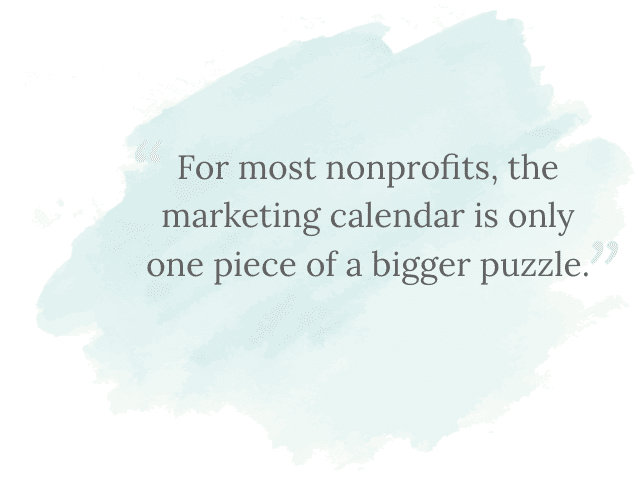
This is the part of the marketing planning process where most nonprofits stop short. They make it through objective setting and tactical planning, but they fail to put the tools and systems in place to ensure their plans will actually be seen through. That’s where our marketing calendar and activity plans come in.
The calendar template gives you a space to plan out your entire team’s marketing activities in fine detail, month-by-month. The action plan template gets even more granular, giving each member of your team a chance to plan out their specific tasks (as they relate to the calendar) on a quarter-by-quarter basis.
Inside the Essential Nonprofit Marketing Plan Template, you’ll find a marketing calendar and activity plan template that you can fill in with your own plans. Don’t feel that you have to take action on each tactic each month. Rather, stagger your activities in a way that is manageable for your team and aligned with your goals.
For most nonprofits, the marketing calendar and activity plans are only one piece of a bigger puzzle that must be completed to ensure that marketing objectives become a reality. We also regularly help our clients with the following:
- Setting up a project management system, where items on the calendar and activity plans get broken down into clear tasks and to-dos with owners and due dates;
- Implementing a meeting cadence to keep their team on track with their marketing plan and ensure everyone is held accountable to what they say they’ll do;
- Setting realistic and sufficient marketing budgets.
Key Messages
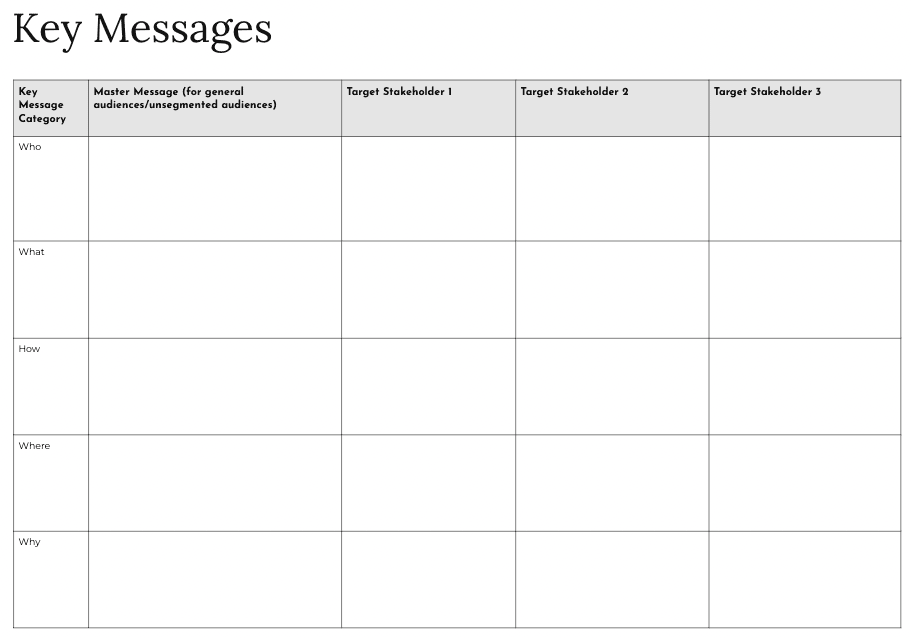
Many people at your organization likely have their own personal version of key messages they use in their day-to-day work, whether they realize it or not. They refer to these “de facto” key messages when meeting new prospective donors, welcoming a visitors and clients to your facilities, training new team members and chatting with friends at cocktail parties. But there is a problem with these personal, informal key messages your staff and volunteers are using. They’re often inaccurate and they’re always inconsistent. Your team members bring their own personal experiences into the way they talk about your organization, but it’s not always easy for them to discuss the bigger picture behind what you do and why.
That’s why we always suggest our clients develop a set of organization-wide key messages as part of their marketing plans. As you might expect, these messages inform marketing elements like your website and marketing activities like media interviews. But they do much more than that. They also give everyone on your team guidance that helps them portray your organization accurately and consistently. Inside the Essential Nonprofit Marketing Plan Template, we’ll guide you through the process of creating a set of key messages segmented by stakeholder group. You can refer to these messages and loosely weave them into future marketing efforts. You can also distribute your final messaging matrix to all your staff and ask them to refer to it in their daily interactions.
Together with your mission, vision and brand, as the foundation for every story you tell about your nonprofit and every marketing touchpoint you create.
Remember, your nonprofit marketing plan should be a living, breathing document.

Ready to get started? Find more guidance, along more examples and tools you can use to build your plan, by downloading The Essential Nonprofit Marketing Plan Template. And if you need more help with your brand strategy and marketing planning efforts reach out.
This post was last updated on April 15, 2022.